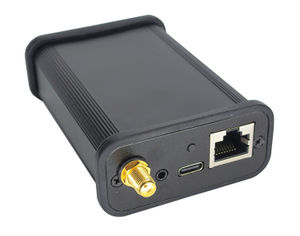E1/T1 Interface
Contents
[hide]Why not TDMoIP / CESoIP?
Usual E1/T1 over IP protocols use generic frames over IP transfer that makes more than 2 megabits constant rate with up to 8000 packets per second. That approach:
- not suitable for distributed sites with limited internet access
- makes constant parasite load on the servers
- requires delays to compensate jitters
- has issues with asynchronous-to-synchronous transition
Fur such kind of integrations we prefer to have our own agent software on-site with hardware E1/T1 interfaces.
- good timings driven by E1/T1 clock or GPS
- good framing due to synchronous composition on the site
- less traffic due to transfer only valuable demultiplexed information
icE1usb
We have chosen Osmocom icE1usb as a primary interface for our projects for several reasons:
- good compatibility with big range of hardware hosts due to use USB
- in opposite to most of DAHDI interfaces it is in production
- open-source hardware design
- open-source user-space driver, no need for the kernel driver
- suitable API for our purposes (at least full-frame mode)
- available at Sysmocom's web shop
User manual can be found here.
NOTICE
Please be careful! Or your device will be damaged! Front-panel RJ45 connectors accepts 120 Om E1. Back-panel RJ45 is for GPIO and accepts TTL only. Don't try to connect the device to Ethernet. USB-C port should be connected to computer, since it's just an interface. Minijack connector is only to reprogram firmware. Also please configure properly internal jumpers to master (NE) or slave (NT) E1 mode.
PLEASE READ USER MANUAL FIRST.
Driver installation
We maintained Osmocom E1D in our Debian repository (amd64, arm64). It has no modifications so you can use any source of packages you want or build from the sources.
- sudo apt install osmo-e1d
Driver configuration
/etc/osmocom/osmo-e1d.cfg
- log syslog daemon
- e1d
- interface 0 icE1usb
- usb-serial [interface serial number]
- line 0
More information about logging section can be found here, here and here.
(If you care about configuration file format, please check the sources here).
How to find a serial number of connected icE1usb:
- sudo lsusb -d 1d50:6145 -v 2> /dev/null | grep iSerial
Reload a service:
- sudo systemctl restart osmo-e1d
You can also test your configuration from the command line:
- sudo osmo-e1d -c /etc/osmocom/osmo-e1d.cfg
Issues with the second E1 port
Please note that on many XHCI host controllers there seem to be implementation flaws in the XHCI host controller firmware preventing the activation of both icE1usb ports simultaneously. The XHCI controller firmware erroneously claims that there is insufficient bus bandwidth. However, the same icE1usb hardware/firmware works perfectly fine with OHCI, UHCI and EHCI host controllers. See https://osmocom.org/projects/e1-t1-adapter/wiki/Isochronous_USB_Issues for a user-maintained list of USB hosts / controllers and whether or not they work with two E1 ports.
In most installations it's not a real issue, because most of installations need in a single port only.
 BrandMeister
BrandMeister